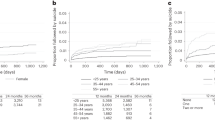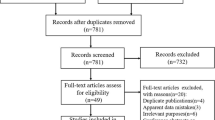Abstract
Non-suicidal self-injury (NSSI) is a common behaviour among psychiatric patients that is easily overlooked and often brings serious consequences. The current literature is limited to certain groups and uses different diagnostic criteria. Here our aim was to investigate the prevalence of NSSI in psychiatric patients in China. Diagnostic and Statistical Manual of Mental Disorders, fifth edition diagnostic criteria were used to conduct a 2-week cross-sectional survey of all psychiatric patients presenting to 15 hospitals in 14 cities across 8 provinces in China during this period. A total of 3,298 psychiatric patients were included. The highest prevalence of NSSI behaviour was found in adolescents aged 10–19 years (14.3%). The prevalence of NSSI behaviour in females in outpatients (16.9%) and inpatients of child and adolescent psychiatric departments (19.6%), outpatients (5.9%) and inpatients adult psychiatric departments (7.7%) was significantly higher than in males. The prevalence of NSSI behaviour in patients with personality disorders was significantly higher than in any other diagnostic group (46.7%, χ2 = 195.239, P < 0.000). The prevalence of NSSI in psychiatric patients is high, especially in adolescents. Therefore, it is necessary to inform patients and medical workers to effectively treat and manage NSSI.
This is a preview of subscription content, access via your institution
Access options
Subscribe to this journal
Receive 12 digital issues and online access to articles
$59.00 per year
only $4.92 per issue
Buy this article
- Purchase on Springer Link
- Instant access to full article PDF
Prices may be subject to local taxes which are calculated during checkout

Similar content being viewed by others
Data availability
The data sets generated and/or analysed during the current study are available from the corresponding author on reasonable request. The participants did not consent to the sharing of the raw data to the public. Source data are provided with this study. The databases used in this study include: https://www.cnki.net, https://www.wanfangdata.com.cn, https://pubmed.ncbi.nlm.nih.gov and https://www.webofscience.com.
Code availability
All code is available at https://www.ibm.com/docs/en/spss-statistics/25.0.0.
References
Nock, M. K., Joiner, T. E.Jr., Gordon, K. H., Lloyd-Richardson, E. & Prinstein, M. J. Non-suicidal self-injury among adolescents: diagnostic correlates and relation to suicide attempts. Psychiatry Res. 144, 65–72 (2006).
Klonsky, E. D. The functions of deliberate self-injury: a review of the evidence. Clin. Psychol. Rev. 27, 226–239 (2007).
Hilt, L. M., Cha, C. B. & Nolen-Hoeksema, S. Nonsuicidal self-injury in young adolescent girls: moderators of the distress–function relationship. J. Consult. Clin. Psychol. 76, 63–71 (2008).
Brausch, A. M. & Muehlenkamp, J. J. Perceived effectiveness of NSSI in achieving functions on severity and suicide risk. Psychiatry Res. 265, 144–150 (2018).
Geulayov, G. et al. Suicide following presentation to hospital for non-fatal self-harm in the multicentre study of self-harm: a long-term follow-up study. Lancet Psychiatry 6, 1021–1030 (2019).
Brunner, R. et al. Life-time prevalence and psychosocial correlates of adolescent direct self-injurious behavior: a comparative study of findings in 11 European countries. J. Child Psychol. Psychiatry 55, 337–348 (2014).
Benjet, C. et al. Non-suicidal self-injury in Mexican young adults: prevalence, associations with suicidal behavior and psychiatric disorders, and DSM-5 proposed diagnostic criteria. J. Affect. Disord. 215, 1–8 (2017).
Kiekens, G. et al. The DSM-5 nonsuicidal self-injury disorder among incoming college students: prevalence and associations with 12-month mental disorders and suicidal thoughts and behaviors. Depress. Anxiety 35, 629–637 (2018).
Swannell, S. V., Martin, G. E., Page, A., Hasking, P. & St John, N. J. Prevalence of nonsuicidal self-injury in nonclinical samples: systematic review, meta-analysis and meta-regression. Suicide Life Threat. Behav. 44, 273–303 (2014).
Plener, P. L., Libal, G., Keller, F., Fegert, J. M. & Muehlenkamp, J. J. An international comparison of adolescent non-suicidal self-injury (NSSI) and suicide attempts: Germany and the USA. Psychol. Med. 39, 1549–1558 (2009).
Buelens, T. et al. Investigating the DSM-5 criteria for non-suicidal self-injury disorder in a community sample of adolescents. J. Affect. Disord. 260, 314–322 (2020).
Kaess, M. et al. Adverse childhood experiences and their impact on frequency, severity, and the individual function of nonsuicidal self-injury in youth. Psychiatry Res. 206, 265–272 (2013).
Geulayov, G. et al. Incidence of suicide, hospital-presenting non-fatal self-harm, and community-occurring non-fatal self-harm in adolescents in England (the iceberg model of self-harm): a retrospective study. Lancet Psychiatry 5, 167–174 (2018).
James, K. M. & Gibb, B. E. Maternal criticism and non-suicidal self-injury in school-aged children. Psychiatry Res. 273, 89–93 (2019).
Bragazzi, N. L., Parigi, D., Pezzoni, F. & Del Puente, G. A content analysis of Italian NSSI websites. Procedia Soc. Behav. Sci. 103, 19–27 (2013).
Cassels, M. & Wilkinson, P. Non-suicidal self-injury in adolescence. Paediatr. Child Health 26, 554–558 (2016).
Kiekens, G. et al. Non-suicidal self-injury among first-year college students and its association with mental disorders: results from the World Mental Health International College Student (WMH-ICS) initiative. Psychol. Med. https://doi.org/10.1017/s0033291721002245 (2021).
Wilkinson, P. O., Qiu, T., Neufeld, S., Jones, P. B. & Goodyer, I. M. Sporadic and recurrent non-suicidal self-injury before age 14 and incident onset of psychiatric disorders by 17 years: prospective cohort study. Br. J. Psychiatry 212, 222–226 (2018).
Perez, S., Lorca, F. & Marco, J. H. ‘Dissociation, posttraumatic stress symptoms, emotional dysregulation, and invalidating environments as correlates of NSSI in borderline personality disorder patients’. J. Trauma Dissociation 21, 520–535 (2020).
Khoubaeva, D. et al. Clinical correlates of suicidality and self-injurious behaviour among Canadian adolescents with bipolar disorder. Eur. Child Adolesc. Psychiatry https://doi.org/10.1007/s00787-021-01803-9 (2021).
Huang, Y. H. et al. Correlation of impulsivity with self-harm and suicidal attempt: a community study of adolescents in Taiwan. BMJ Open 7, e017949 (2017).
Nock, M. K. Self-injury. Annu. Rev. Clin. Psychol. 6, 339–363 (2010).
Ose, S. O., Tveit, T. & Mehlum, L. Non-suicidal self-injury (NSSI) in adult psychiatric outpatients—a nationwide study. J. Psychiatric Res. 133, 1–9 (2021).
Groschwitz, R. C. et al. The association of non-suicidal self-injury and suicidal behavior according to DSM-5 in adolescent psychiatric inpatients. Psychiatry Res. 228, 454–461 (2015).
Liu, R. T. The epidemiology of non-suicidal self-injury: lifetime prevalence, sociodemographic and clinical correlates, and treatment use in a nationally representative sample of adults in England. Psychol. Med. https://doi.org/10.1017/s003329172100146x (2021).
Tang, J. et al. Prevalence of and risk factors for non-suicidal self-injury in rural China: results from a nationwide survey in China. J. Affect. Disord. 226, 188–195 (2018).
Liang, S. et al. Differences between non-suicidal self injury and suicide attempt in Chinese adolescents. Asian J. Psychiatr. 8, 76–83 (2014).
Yang, S. J., Jo, H., Kim, J.-G. & Jung, S. H. Baicalin attenuates laser-induced choroidal neovascularization. Curr. Eye Res. 39, 745–751 (2014).
Andover, M. S. Non-suicidal self-injury disorder in a community sample of adults. Psychiatry Res. 219, 305–310 (2014).
Hata, Y. et al. Antiangiogenic properties of fasudil, a potent Rho-Kinase inhibitor. Jpn. J. Ophthalmol. 52, 16–23 (2008).
Salk, R. H., Hyde, J. S. & Abramson, L. Y. Gender differences in depression in representative national samples: meta-analyses of diagnoses and symptoms. Psychol. Bull. 143, 783–822 (2017).
Victor, S. E. et al. Characterizing gender differences in nonsuicidal self-injury: evidence from a large clinical sample of adolescents and adults. Comp. Psychiatry 82, 53–60 (2018).
Buelens, T., Costantini, G., Luyckx, K. & Claes, L. Comorbidity between non-suicidal self-injury disorder and borderline personality disorder in adolescents: a graphical network approach. Front. Psychiatry 11, 580922 (2020).
Yadav, U. C., Srivastava, S. K. & Ramana, K. V. Prevention of VEGF-induced growth and tube formation in human retinal endothelial cells by aldose reductase inhibition. J. Diabetes Complicat. 26, 369–377 (2012).
Zetterqvist, M., Lundh, L.-G., Dahlström, Ö. & Svedin, C. G. Prevalence and function of non-suicidal self-injury (NSSI) in a community sample of adolescents, using suggested DSM-5 criteria for a potential NSSI disorder. J. Abnorm. Child Psychol. 41, 759–773 (2013).
Acknowledgements
This study was supported by Jiangsu Provincial key research and development programme (BE2019609), the National Natural Science Foundation of China (81971289 and 81871344), the Natural Science Foundation of Jiangsu Province (BK20191369) and the Qing Lan Project of the Higher Educations of Jiangsu Province. We thank all the participants for their time and dedication, and B. Zhong for help with the revision of the paper.
Author information
Authors and Affiliations
Contributions
Data curation and formal analysis were carried out by P.Z. L.O. wrote the original draft. M.L., Y.W., C.B., K.Y., Yuan Liu, J.L., X. Wang, G. Liu, X.J., Y.S., H.L., X. Wu, S.W., G. Li, B.Z., Yang Liu and J.H. carried out data collection. C.W. reviewed, edited and critically revised the paper. All authors read and approved the final paper.
Corresponding author
Ethics declarations
Competing interests
The authors declare no competing interests.
Peer review
Peer review information
Nature Mental Health thanks Rebecca Babcock Fenerci and the other, anonymous, reviewer(s) for their contribution to the peer review of this work.
Additional information
Publisher’s note Springer Nature remains neutral with regard to jurisdictional claims in published maps and institutional affiliations.
Data sharing The data analysed during the current study are available from the corresponding author on reasonable request.
Supplementary information
Supplementary Information
Supplementary Tables 1–4.
Rights and permissions
Springer Nature or its licensor (e.g. a society or other partner) holds exclusive rights to this article under a publishing agreement with the author(s) or other rightsholder(s); author self-archiving of the accepted manuscript version of this article is solely governed by the terms of such publishing agreement and applicable law.
About this article
Cite this article
Zhang, P., Ouyang, L., Liang, M. et al. A cross-sectional epidemiological study of non-suicidal self-injury prevalence in Chinese psychiatric patients. Nat. Mental Health 1, 266–272 (2023). https://doi.org/10.1038/s44220-023-00050-y
Received:
Accepted:
Published:
Issue Date:
DOI: https://doi.org/10.1038/s44220-023-00050-y
This article is cited by
-
Cognitive Behavioral Therapy in China: Practices and Exploration
International Journal of Cognitive Therapy (2024)



